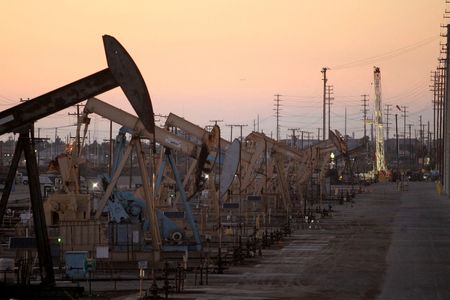By Arathy Somasekhar
HOUSTON (Reuters) – Oil prices rose more than $1 a barrel on Tuesday as sources said OPEC+ is considering extending voluntary oil output cuts into the second quarter to provide additional support.
Brent crude futures rose $1.12, or 1.4%, to $83.65 a barrel, while U.S. West Texas Intermediate crude futures (WTI) were up $1.29, or 1.7%, at $78.87.
The Organization of the Petroleum Exporting Countries and allies led by Russia, known as OPEC+, agreed in November to voluntary cuts totalling about 2.2 million barrels per day (bpd) for the first quarter this year, led by Saudi Arabia rolling over its own voluntary cut.
The producer group could keep the additional cuts in place until the end of the year, two of the sources told Reuters.
“We are going to see some tight supplies down the road,” said Dennis Kissler, senior vice president of trading at BOK Financial.
“OPEC is looking for mid-$80s, may be around $85 a barrel on Brent. If we stay below that, they will curtail production all the way to the year end,” Kissler added.
Also supporting prices on the supply side, Israel and Hamas, as well as Qatari mediators, all sounded notes of caution about progress towards a truce in Gaza, after U.S. President Joe Biden said he believed a ceasefire could be reached in under a week to halt the war for Ramadan.
Yemen’s Houthi spokesperson said the group’s operations in the Red Sea would stop only when Israeli “aggression” against Gaza ends. Houthi missile and drone attacks on international shipping have driven up the cost of transporting energy products and contributed to a tighter market.
In the U.S., crude inventories were expected to have risen about 2.7 million barrels last week, while distillates and gasoline stockpiles were seen falling, a Reuters poll showed.
The American Petroleum Institute will release the industry group’s weekly U.S. crude inventories data at 4:30 p.m. EST (2130 GMT), followed by the government’s report on Wednesday morning.
Meanwhile, the 3-2-1 U.S. refinery crack spread <CL321-1=R>, a proxy for refining margins, rose to their highest in more than five months. The surge suggests increased profitability for refineries amidst robust consumer demand for petroleum products.
Markets expect to see some improvement in Chinese oil demand as improving travel demand over the Lunar New Year holiday outweighed worries of slowing macro-economic indicators.
Russian authorities announced a six-month ban on gasoline exports from March 1 to compensate for rising demand and to allow for refinery maintenance.
Global crude oil markets were expected to be fairly stable this year at around $80 a barrel, Russel Hardy, CEO of oil and gas trader Vitol, said.
Speaking at the Energy Institute conference, Hardy also said global oil demand was expected to peak in the early 2030s.
Both oil benchmarks had settled more than 1% higher on Monday after declines of 2-3% over the previous week as markets factored in a greater likelihood that cuts to interest rates might take longer to come than previously expected.
(Reporting by Paul Carsten in London, Arathy Somasekhar in Houston and Andrew Hayley in Beijing; Additional reporting by Ahmad Ghaddar; Editing by Marguerita Choy and Nick Macfie)

